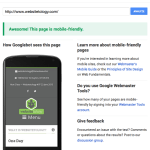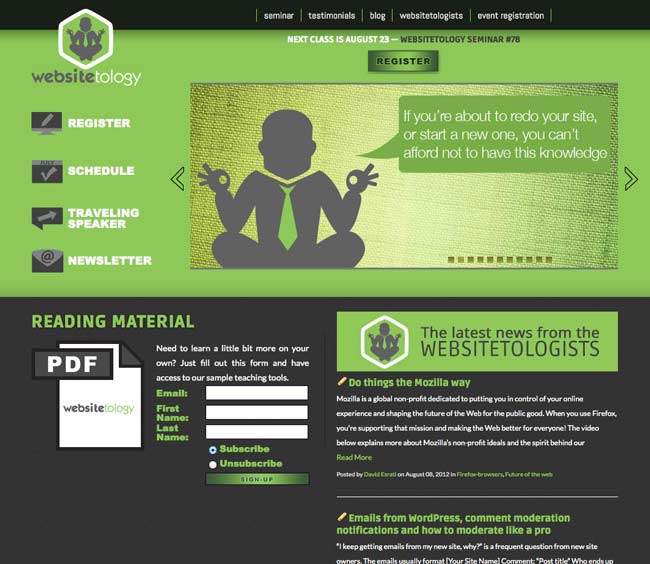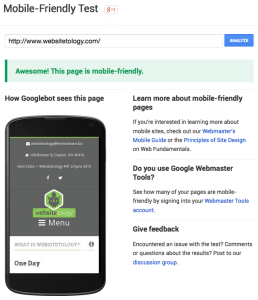In April of 2015 Google announced that they would give search rank preference to sites that were mobile friendly (responsive, you can use Googles test page to check your site) and that had a secure certificate. Secure certificates create a “Secure Sockets Layer” or SSL- the lock or green bar, or HTTPS you see in the browser address bar.
Installing SSL’s can be a pain, and it’s another product domain registrars and hosting companies and the certificate issuers can charge you more for. Our solution at Next Wave Hosting is to become a partner with CloudFlare– that provides a workaround that provides SSL without a certificate and without additional cost to our clients.
But- if you want to learn the reasoning behind Google’s move- you can watch this 45 minute video where two of their engineers explain it pretty convincingly without getting too geeky.
They want your site to be Secure By Default.
Their three main reasons for HTTPS:?
- People can’t listen in on conversations between your visitors and your site,
- They can’t tamper with the data
- They can’t impersonate the destination.
They also provide tips on installing secure certs and where to get them, and most importantly- how to fix your existing site so that your content and links all display properly.
We found the Search and Replace plugin for WordPress very handy. We had to look for hard coded internal links to
http://oursite.tld/test/index.php
and turn those into relative links (within a site a link doesn’t need the full domain),
test/index.php
The lack of a leading slash means “Inside the current directory is a sub-directory named test, and inside that directory is a file named index.php“.
All of our video content- such as youtube.com links and the newer shorter ones youtu.be both had to be found that were http, and changed to https to properly display.
While all this may seem like a lot of work for you, in the end, you’ll be rewarded with higher search rank, peace of mind, and your customers will be more confident about their experience on your site.
If you need help moving over to HTTPS feel free to contact us.
In one of our most recent email newsletters, we pointed readers to Google’s Mobile-Friendly Test so that people could check to make sure their sites weren’t being penalized. This link was far and away the hottest item in the email, with over 400% more clicks than any other link in the newsletter.
In spite of Google’s attempts at emphasizing the importance of mobile-friendly design, and later on their tough-love warnings that your sites will be punished after April 21st, the message seems clear to us: people, businesses, and their websites are being left behind and many are unsure what to do to catch up.
Some may breathe a sigh of relief upon receiving a passing mark from the test, but what if you’re left with a big, fat F?
Over at our agency, The Next Wave, we commonly receive requests to “add responsiveness to our existing site.” We understand that this kind of request comes from a good place: folks who are looking for an inexpensive and painless way into the mobile-friendly realm by “adding on” the mobile functionality.
The problem is that this is actually pretty difficult, in some cases impossible, to achieve from a designer and developer’s perspective.
Mobile-friendly designers will typically start designing a website by how it looks like on mobile devices, then expanding and scaling the design outwardly from there. The idea is that everyone will be looking at essentially the same website, and there is no inferior way to browse.
Mobile-friendly developers mostly code websites as a giant grid to complement this aforementioned approach to design. For instance, each item on a typical WordPress site: posts, sliders, headlines, forms, and etc. are placed inside various squares of a grid. This makes it very easy to scale websites. As the screen becomes larger and smaller, you can shift the grid around so that everything still fits, but the code itself stays the same underneath.
Most developers who are giving an old site true responsiveness are essentially coding a new site from scratch but still wrapping it up in your design that looked good back in 2010. It makes more sense to just go back to the drawing board and start fresh.
By now I can feel your frustration coming through. You’re likely thinking, “This is all well-and-good, but I still can’t afford the time/money to invest in a brand new website right now.” You might even be thinking that there’s nothing wrong with your site as it is, except for Google’s stupid new rule.
If you’re a WordPress user, there are a few plugins out there that can take your pages, posts, etc. and wrap it in a separate mobile site. Notably WPTouch—with a couple free themes—and the mobile theme feature in Jetpack. Desktop users will still see your same-old site, and mobile users will be served up something different.
Keep in mind, however, that your mobile users will be looking at an inferior version of your site that might not work very well. Eventually, you’ll have to move on.
It’s not as intimidating as it seems, we promise. In fact, you could do it yourself over a long weekend. That’s what our seminar can show you.
If you’ve been following us a while, you might remember our post all the way back in 2012, where we unveiled our newest, shiny design to bring us into the twenty-teens. The adage about cobblers and shoes we used then once again started ringing true in 2015. We’ve always been in the loop about what makes a great website, even from a design standpoint, but usually those things were reserved to our clients over at The Next Wave and spreading the word to our seminar attendees.
So much has changed even in the three years since our previous design. The biggest of which is the rise of responsive web design, which allows a website to adapt to whatever device a user is viewing the website so that it never looks wrong. With this technology comes a “mobile-first” approach to design, in which websites are designed with mobile devices in mind, then scaled up and enhanced for laptops and desktops.
With Google’s mandate that sites be mobile friendly or face consequences in the search engine rankings, we knew we couldn’t wait around any longer to give our site a new facelift. So if you’re reading this post on our website, you’re looking at the new Websitetology design.
Maybe the space aesthetic isn’t your thing. That’s cool. The great thing about the way this site was designed and coded is that the thematic images throughout the site, including the slides on the homepage, can be easily swapped out for new ones without altering a single bit of code. We can return to Earth and give the site a fresh look at a moments notice.
So what do you think? Love it? Have any constructive criticism? Leave your comments below.









